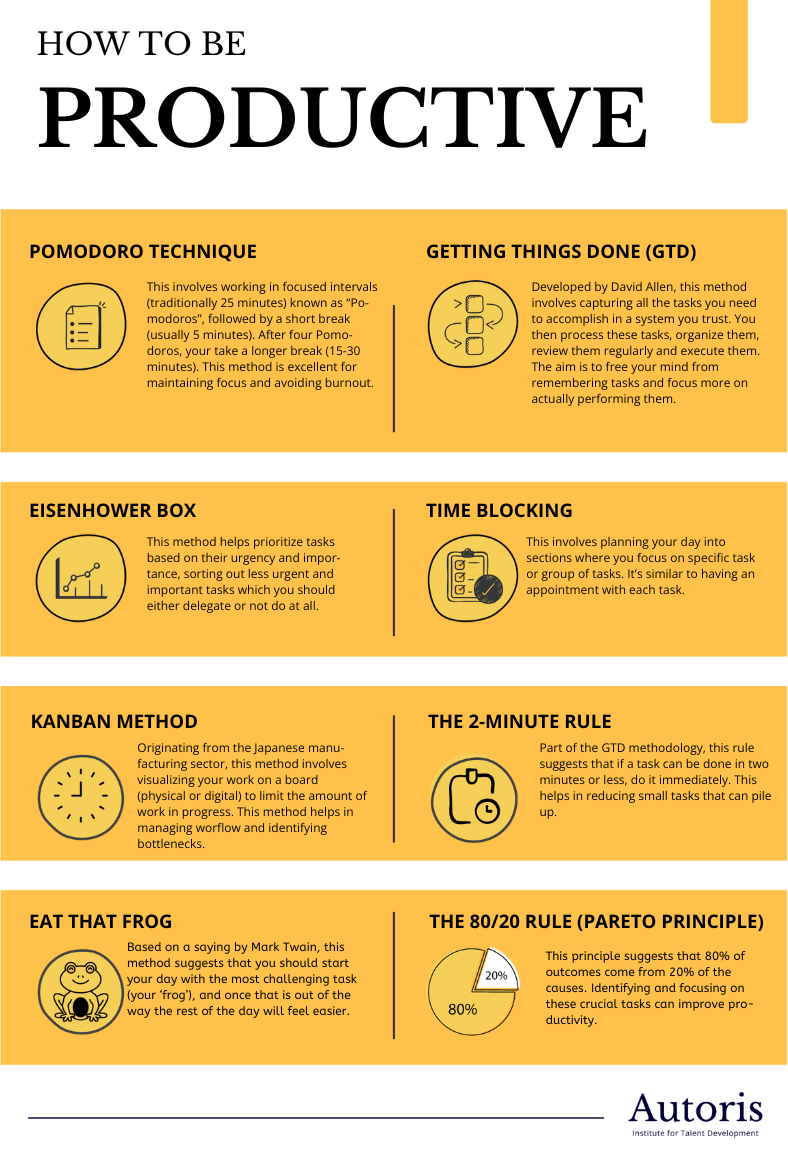In-Depth Techniques and Actionable Tips
Upping your productivity game isn’t just about nailing that to-do list. It’s more about smart time management, zeroing in on the most vital tasks – a bit like mining Bitcoins from a blockchain of chores. So let’s break down some well-tested productivity tactics and give you actionable tips, kind of like repurposing video content into deeply written articles for your life.
Pomodoro Technique
Description: The Pomodoro Technique is a time management method that breaks down work into intervals, traditionally 25 minutes in length, followed by a five-minute break. These intervals are named “pomodoros,” after the Italian word for ‘tomato,’ referencing the tomato-shaped kitchen timer that Cirillo used as a university student. This technique encourages frequent breaks to mitigate mental fatigue.
Tip: Use a physical timer to create a ritual that signals to your brain the start and end of work periods. The act of setting the timer reinforces your commitment to the task at hand.
Getting Things Done (GTD)
Description: GTD is a work-life management system that alleviates the mental load of keeping tasks in your head. By capturing tasks externally and breaking them down into actionable work items, you can focus on executing tasks without the distraction of remembering them. It consists of five steps: capture, clarify, organize, reflect, and engage.
Tip: Clearly define the next actionable step for each task, so you never have to wonder what ‘start work’ actually entails.
Eisenhower Box
Description: This technique helps you quickly determine which tasks in your busy schedule are truly important and which are not. By categorizing tasks into ‘Urgent and important,’ ‘Important but not urgent,’ ‘Urgent but not important,’ and ‘Neither urgent nor important,’ you can decide where to focus your energy.
Tip: At the end of each day, draft an Eisenhower Box for the next day to visualize where your priorities should lie, thus eliminating decision fatigue.
Time Blocking
Description: Time blocking involves planning out your day in advance and dedicating specific hours to certain tasks or responsibilities, like appointments with yourself. This method ensures that you have a structured plan for your workday, which can lead to increased productivity and a better work-life balance.
Tip: Allow time for interruptions and transitions when planning your blocks to ensure your schedule remains flexible and realistic.
Kanban Method
Description: Kanban is a visual system for managing work as it moves through a process. It visualizes both the process (the workflow) and the actual work passing through that process. The goal of Kanban is to identify potential bottlenecks in your process and fix them so work can flow through it cost-effectively at an optimal speed or throughput.
Tip: Implement work-in-progress (WIP) limits to prevent overcommitment on tasks and to keep your focus on task completion.
The 2-Minute Rule
Description: This rule, as part of the GTD methodology, posits that if you determine an action can be done in two minutes, it should be done at that moment. This principle helps manage small tasks that otherwise might occupy unnecessary mental space or clutter your to-do list.
Tip: After completing a quick task, take a moment to note down what the following action for that project is. This keeps the momentum going and helps to maintain a clear direction.
Eat That Frog
Description: Based on Mark Twain’s concept that if the first thing you do each morning is to eat a live frog, you’ll have the satisfaction of knowing that it’s probably the worst thing you’ll do all day. The ‘frog’ is your biggest, most important task, the one you are most likely to procrastinate on.
Tip: Identify your frog the night before, and make it the first task you tackle in your day to ensure high-priority tasks are completed.
The 80/20 Rule (Pareto Principle)
Expanded Description: The Pareto Principle, named after Italian economist Vilfredo Pareto, specifies that 80% of consequences come from 20% of the causes, asserting an unequal relationship between inputs and outputs. This concept helps prioritize tasks that have the most significant impact on your goals.
Specific Tip: Regularly reassess your tasks to determine which are part of the 20% leading to 80% of your results, and focus your energy accordingly.
Summary
Adopting these tips into your daily grind can help you craft a smoother, more productive balance between work and life. It’s all about tweaking them to mesh with your unique style and requirements – find that sweet spot!



